The Court Treatt Expedition 1924-1926
The Expedition Part 3 - Sudan and Egypt
Southern Sudan
Crossing into Sudan they had to be checked for Yellow Fever (the only mention in the book of any border formalities) then headed north to the Nile steamer port of Mongalla. The bridges on this road were made of split cane and although they looked too fragile to take the weight of the car were in reality strong but bendy. Mongala was reached on the 18th October, the journey from Nairobi having taken only eight days.
In Mongala they were received by Major Brock, the Governor, and stayed in the house of the station doctor who was away. While they were there the river steamer arrived. Local officials warned of the swamps of the Sud ahead and strongly recommended that the cars be put on the steamer to get round the obstruction but the offer was declined. The steamer was used to tow a raft over the river on which the cars were loaded and they were got off and back onto land only after the exertions of a large local gang employed to dig a ramp up the river bank. Before setting off into the unknown a final dinner was had on the steamer.
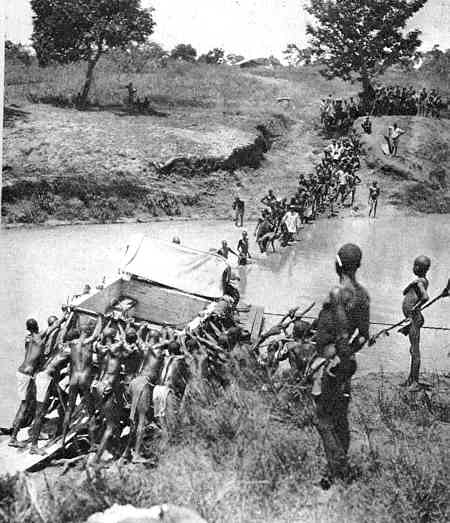
On the 25th October at 10.00 am they set off, driving through grass and reeds that were above head height reducing visibility to virtually zero but at least the ground was reasonably solid having had a chance to dry out. Being in a wetland they were also plagued by mosquitoes. The aim was to get to Terrakekka, about 60 miles further north on the banks of the Nile and they decided to drive through the night handicapped by the lights not working on the second car as the battery was flat. Around 10.00 o'clock at night they stopped to fill up the radiators. It had been raining steadily and the ground was covered in water but on top of this was floating some petrol from a spill and disaster nearly happened when someone threw a match out of the window and the whole surface caught fire nearly destroying the vehicles. Fortunately it was put out just in time. The wetland swamp was interspersed with bush and trees and a track just wide enough had to be cut through these making driving in the dark especially difficult.
They continued skirting the worst of the swamp but still kept getting bogged down in thick clay and the block and tackle came into use again. The rain continued but the ground dried out much quicker than in Rhodesia. Nights were spent in rest huts which were located on pieces of higher ground and getting to these meant some very long driving days. The route would take them well to the west of the Nile to avoid the Sud swamps and passed through Amadi, Meridi, Mvolo, Gnopp, Atwot, Rumbek (3rd November), Bahr el Gell, Tonj, Aweil (22nd November), the Chel river, Nyamlell, Malau, Bahr el Arab (30th November), Abu Matarick (14th December), Abu Gabra, Muglad, Abu Zabad and into El Obeid which they eventually reached on 20th December.
To cover this part of the journey they usually had to wait until late morning before setting off as by then the sun would have burned off some of the water of the track making the going slightly better but a typical days distance covered could be as little as eight miles. Rumbek was reached on November 3rd and near there they had to cross the Naam River (now usually called the Jur) by dragging it across the river bed. The carburettors and electrical equipment was taken off and the water got as high as the tops of the seats.
November 4th was so wet that they did not even try to move and on the 5th they were stuck in one place from 12.30 until 10.00pm. They now entered the country of the Dinka and the local people were used more and more to haul the cars through swamps and across rivers on makeshift rafts.
As they got further north a further problem arose as there were no more trees for raft building and some rivers were up to 20 feet deep. The solution was to drag the cars across on the river bed under water. The vehicles would be completely stripped and all holes in the engine blocked with wooden plugs and candle wax. The first time this was tried was on the Bahr el Gell. Two ropes were fastened to the front of the car and about fifty people rounded up to pull.
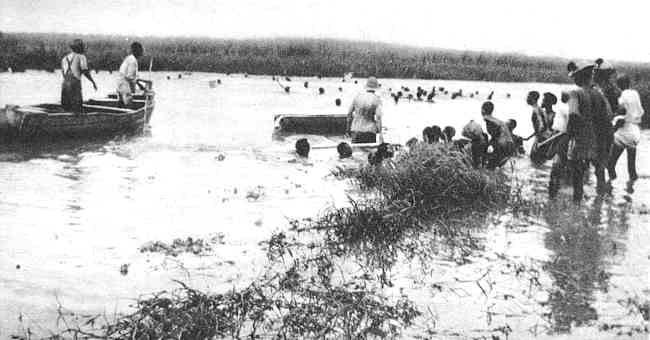
with Major Court Treatt standing on the back
Just in case the rope broke, and it did, a float was tied to the rope at the car end so it could be located under water. The steering was lashed down with a rope with just a little free play and the car was gently rolled down the shelving bank and into the water. C.T. himself rode on the car and when it went completely under pulled himself clear. The fuel tank at the rear was sealed and acted as a float so the back kept out of the water. In the middle the rope broke but there were sufficient helpers still holding the car to stop it being swept away and with the help of the float the loose end was found and the rope re-tied by Julius and Errol. The car was completely invisible in the muddy water but eventually some bubbles were spotted and C.T. was able to get his feet and then hands on the steering wheel. Just as they thought all was safe the car dropped into a deep channel and stuck firmly in the mud. The only way to get it out was to dive down and scoop away the mud making a slope to drag it up.
With the lessons learnt the second car had its fuel tank filled with water keeping it on its wheels all the way across. The engines were purged of water by removing all the bungs and getting the locals to pull them along in bottom gear to pump it out. Putting back all the engine parts and getting them running took about two and a half hours. In all seventeen rivers were crossed in this way.
Wau, where they were met by the acting Governor, was reached on the 14th November and a short break was taken to overhaul the cars. To help communication, as none of them spoke the local language, a local guide called Musa was taken on at Wau and he spoke Arabic, Swahili and some English. To give instructions, Major Court Treatt would speak to Julius in English who translated it into Swahili for Musa who in turn had to find a Dinka who spoke Arabic.
It was then on to the last government post at Aweil where they arrived on the 22nd November and got what information they could on the next obstacle of the valley of the Bahr el Arab.
Central Sudan
Much of the next section around the Bahr el Arab river was blank on the maps marked "unsurveyed" and "uninhabited". From the village of Malau it was about eighty five miles to Sala where there was supposed to be a road and river crossing. To get through the tall grass a party of local boys went ahead and set fire to it. This sometimes got out of control and dangerously near the cars. The toich (swamp along the river side), about eight miles wide, of the Bahr el Arab river was reached on the 30th November and the search started for a place to cross. The river was the boundary between Dinka and Arab territory and a group of four Arabs was captured on "their" side by some of the Dinka helpers. They had clearly got across but were unwilling to give up their secret. As they were being seriously threatened by the Dinka they were put under "arrest" and guarded by an Askari (soldier) who was with the party. In return for being kept safe they were persuaded to show where there was a possible crossing and Major Court Treatt went to investigate and decided a bridge could be built. The problem was that there were no trees for miles so all the wood for the bridge had to be dragged a considerable distance and the river was up to 25 feet deep.
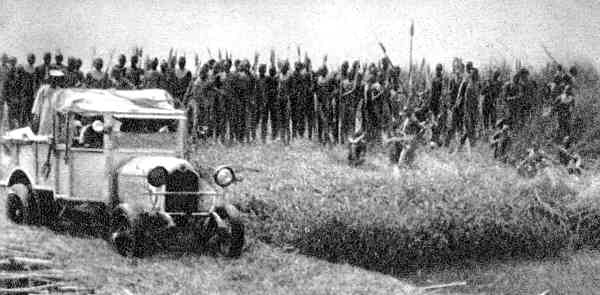
On December 5th the bridge was decreed finished and the cars were dragged through the toich by about 250 local people. The first car crossed the bridge safely, in spite of the structure sinking into a hole, followed by the second one with no mishaps. On the far side there was a further toich to cross but as this was now Arab territory the Dinka did not want to enter. They were persuaded in the end by being given two deer that had been shot especially.
They set off again with some Arab guides through a wooded area. Food was getting short with little apart from some bush meat and grain. The tea, salt and rice had run out and the coffee was running very short. The promised road did not exist and on December 7th they hit another toich and this time there were no local people to help.
The only way through was to cut trees and branches and lay them in the swamp to make a roadway. A small river, called the Ardeb, in the middle of the toich was crossed at noon on the 11th. Another river, the Gatchi-Gatchi was crossed with the aid of block and tackle on the 12th. The path was bad being full of holes made by elephants during the rains and the cars constantly crashed into them but on the 14th December the small Arab encampment of Abu Matarick was reached and the swamps were behind. The first motor vehicles had now crossed the Bahr el Arab. In front lay the desert and a road which meant one day's journey to Abu Gabra where there was a government station.
Good roads continued, and this time it was a road although often very sandy, and good time was made through Muglad and Abu Zabad heading towards the next target of El Obeid. However, about 40 miles short of this destination wheels collapsed on both cars. Many spokes had been broken when traveling through the rough country. So, taking a wheel from the No. 2 car they patched up No. 1 and arrived in El Obeid to have tea with the Governor and his wife. A rest house was put at their disposal and spare wheels were ordered from the Khartoum dump but they did manage to borrow a couple locally and bring in the abandoned car.
They did some shopping for Christmas and actually set off on the morning of the 25th. That evening they made a large fire and sat out in the desert reminiscing about the soaking wet Christmas they had spent the previous year in Rhodesia. A special meal was cooked by Julius including a turkey bought in El Obeid. The next morning they left at 6.00 am and kept going until midnight hoping to reach the Nile again but not quite succeeding. The next morning, the 27th, they did reach the Nile at the large town of El Dueim and once more were entertained by the Governor and even had baths. The cars were taken over to the east bank of the river by steamer and it was off again at sunset traveling a few miles before making camp.
Northern Sudan
Khartoum was reached early the next afternoon. They stopped only briefly to sort out some paperwork, delayed to the next day because all the government offices were shut and on the 29th it was back out into the desert at 05.30. A brief stop was made to shop at Omdurman which entailed taking a ferry across the river leaving the cars behind. Re-equipped they continued north to the confluence of the Blue and White Nile rivers crossing the Blue Nile on the 700 yard long iron bridge. Heavy sand was met on the 30th and they broke another spring, so only 75 miles was covered in a long day. The night was spent at the village of Omda. On the last day of the year a good run was made to the town of Shendi having passed through the ruins of the ancient city of Meroe.
On 1st January 1926 the capital of Berber province, El Damer was arrived at and a local guide was hired. The night was spent with the District Commissioner at Berber after crossing the Atbara river by using the railway bridge. The railway was converted into a temporary road by laying wooden planks alongside the rails but as they only had enough to progress about 12 feet each time before moving the planks forwards, the crossing took 3 hours. There is no mention of any trains.
The local guides new the best way to go taking them quite along way from the river but kept them on hard sand so on January 2nd they managed to cover 128 miles. At Abu Hamed the Nile turns to the east but the railway goes directly north cutting off a large bend so the railway was followed and on the 4th they ran alongside and overtook an express train reaching 40mph. Halfa and the Nile were reached on the evening of the 5th and a break was taken to visit the temples of Abu Simbel by steamer. The book describes villages along the bank of the river and lots of islands now all submerged under Lake Nasser.
Egypt
Beyond Halfa was an area unknown to the guides and the advice was that the journey to Shellal in Egypt was impossible. As in this area the Nile is (or was before the lake) flanked by rocky hills the way north meant going well to the east and crossing the desert in an area with no water and no roads and the strong possibility of getting stuck in deep sand.
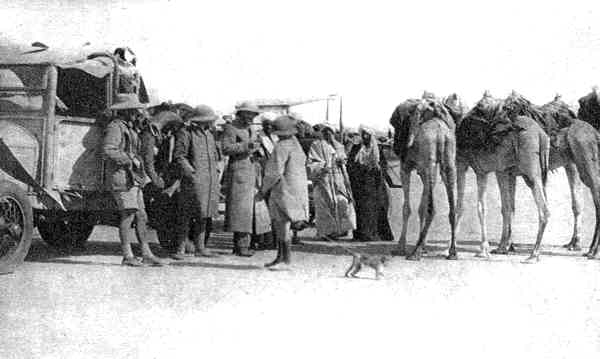
Halfa was left on January 8th with lightened loads but lots of water. A delay happened when the No. 2 car's radiator started leaking so to be on the safe side it went back to Halfa to be repaired. The weather turned overcast with strong winds and even some rain and it was extremely cold but progress over the firm sand was generally good. On the 9th the hard surface ended as they ascended into the mountains and the second car in particular kept bogging down. Progress was halted on the next day when a spring again broke and only 63 miles was covered. Repeated attempts to find a way through the mountains by going east were tried and abandoned and the frustration of this was compounded by a series of punctures and one tyre which had been on the car since Cape Town had to be abandoned. The guides finally announced that they were lost on the 12th but Julius finally found a dry valley leading down towards the Nile valley. A camel track was found on the 13th and later the same day they met a search party on camels sent out from Aswan who told them they were only 3 miles from the village of Allaghi on the banks of the Nile.
At Allaghi there was a road up the west bank and a steamer was expected that could take them over but this did not materialise so arrangements were made to cross the river by felucca. A platform was built on the deck to take the cars one at a time and on the 16th the crossing was made with the felucca towed by motor boat. Shellal was finally reached on the 18th and as it was on the other side of the river they drove across the dam then proceeded along the river to Aswan.
There was now a good road and Esna was passed on the 19th and Luxor reached on the 20th with a luxurious night spent in the Luxor Hotel. The 21st was given over to some sightseeing but on the 22nd it was off again. At each town they reached there was a guide on horse back waiting to show them the way through the narrow streets. Camp on the night of the 22nd was on the road itself while Errol and Julius changed the complete axle on No.2 car.
The morning of the 24th January 1926 was to be the last day of the journey. Julius and Musa woke the rest of the party with hot tea and the best clothes were put on with Julius shaming everyone else by appearing in an immaculate khaki suit he had saved for the occasion. A large reception party waited at their destination under the pyramids of Giza. There were bouquets of flowers, reporters and cameramen to record the arrival. The final run was along the main road, the Kasr el Nil, into Cairo itself. The road was closed to all other traffic and large crowds lined the sides until the journey finished at their hotel in the city centre.
Aftermath
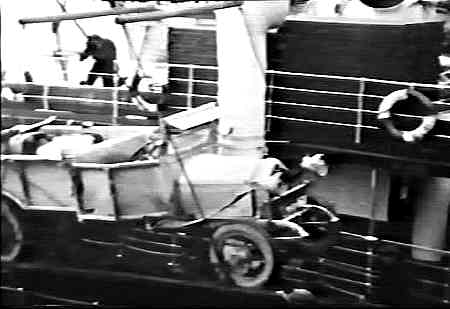
Although the story in the book stops in Cairo, the journey actually continued. The cars were driven to Alexandria and put on a ship to Marseilles. From Marseilles they drove across France to the English Channel and then once again traveled by ship to Dover from where they drove to London and more welcoming parties. Radio broadcasts were made and dinners attended. A special reception was organised at Major Court Treatt's home village in Surrey. Once the film was finished a publicity tour with the cars was made but without the expedition members.
The party dispersed with the Court Treatts and Errol going on to make more journeys and films in Africa. The cars were returned to the Crossley factory in Manchester - their ultimate fate is unknown.
Throughout southern and eastern Africa a major road building programme was already starting as the expedition was under way. The Rhodesian "strip road" programme started in 1925 and within a few years driving ordinary cars over much of the route would be almost routine. Three English ladies did the journey in around 1928 in a 1924 Morris Oxford tourer as described in the now rare book "Cape to Cowley" (Methuen 1932). However, to follow the route today is not possible and most people driving the length of Africa go through Ethiopia. Southern Sudan and Northern Uganda have both seen major armed conflict. The roads in Southern Sudan are still not all weather and have never been passable in the rainy season. There is now also the added danger of land mines. There are no roads around Lake Nasser which was formed after the Aswan High Dam was completed in 1970 and the area is also a military zone and formally closed to driving. Vehicles have to be carried on the ferry that runs from Wadi Halfa to the port near the dam which is a few miles south of Aswan. Maybe things will improve to allow a celebration run in the centenary year of 2024.